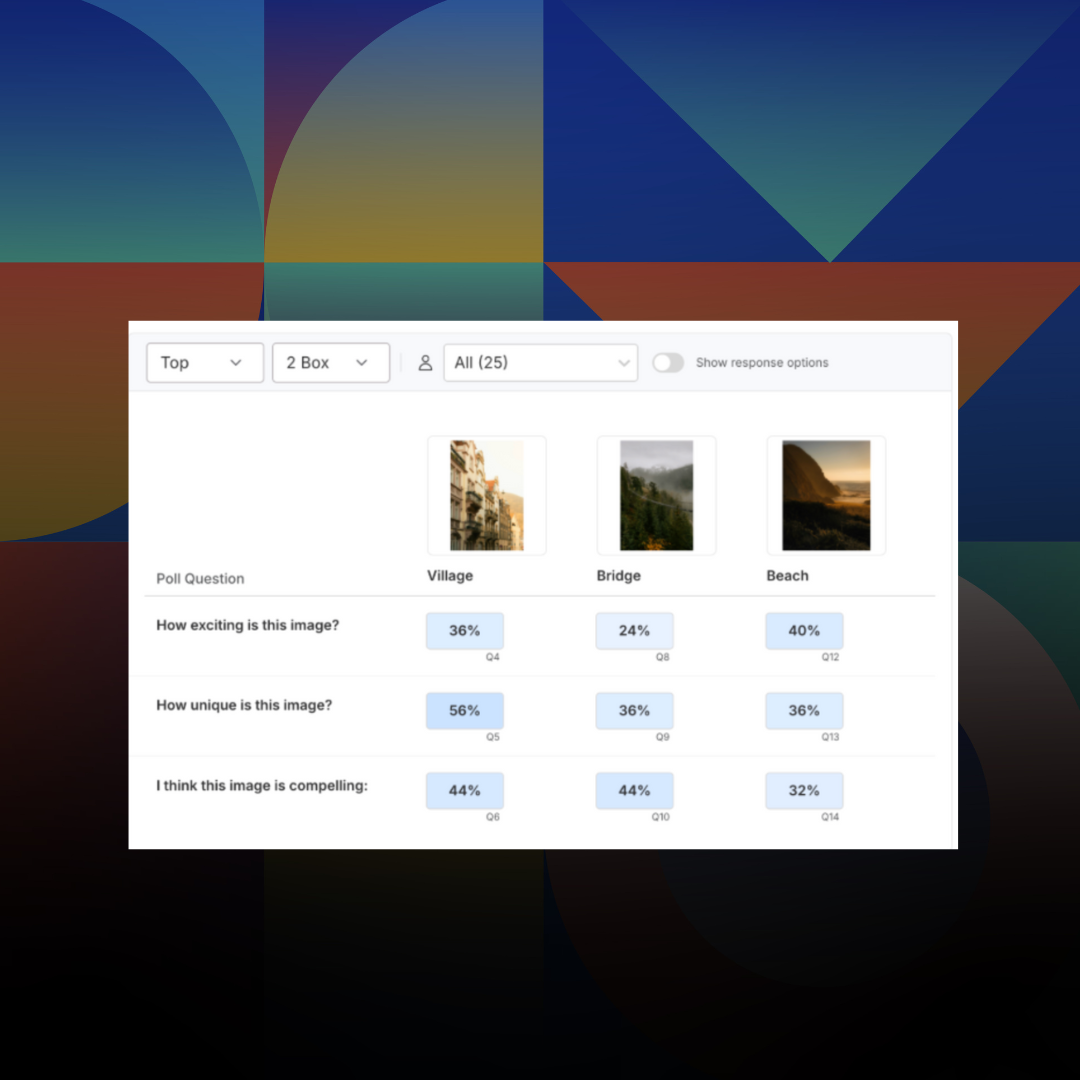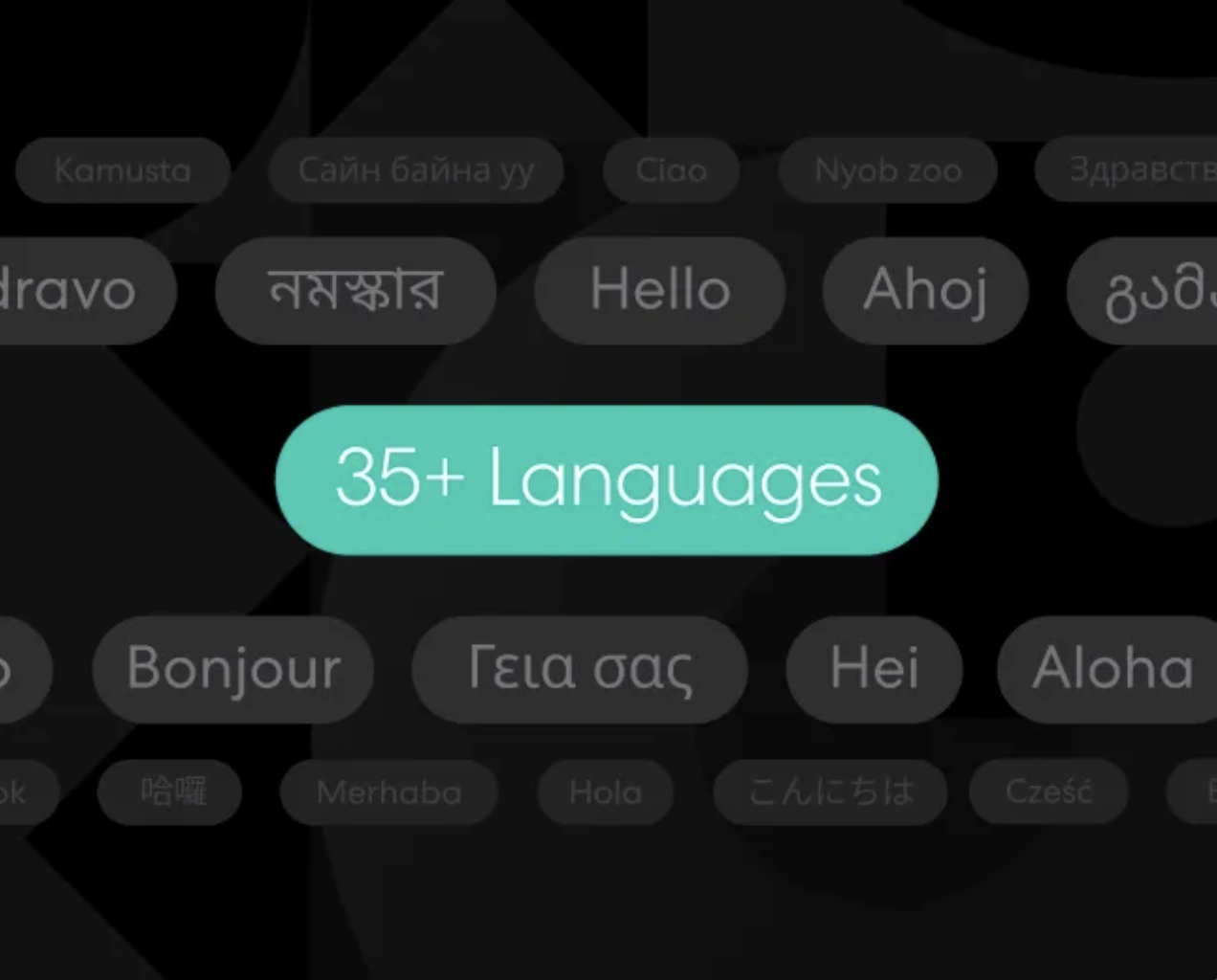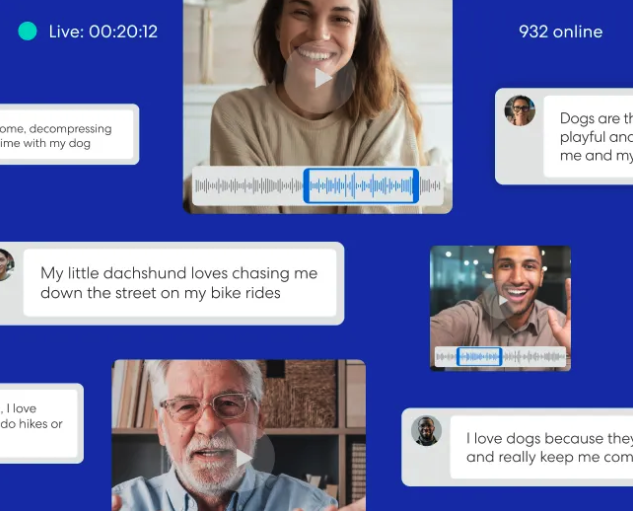
Research 101
Introducing: Poll Comparison - Streamline Concept Testing and Make Better Decisions Faster
Emmet Hennessy
November 24, 2025
Market Research
Articles

Research 101
Introducing: Poll Comparison - Streamline Concept Testing and Make Better Decisions Faster
Emmet Hennessy
November 24, 2025
Market Research
Articles

AI
Purpose-Built for Research AI is Here - a Letter from the CPO
Jessica Dubin
October 21, 2025
Market Research
Articles

AI
Purpose-Built for Research AI is Here - a Letter from the CPO
Jessica Dubin
October 21, 2025
Market Research
Articles

Advanced Research
Unlock Agile Global Insights: Using Remesh Multi-Language Conversations for Research Across Audiences
Customer Success Team
October 14, 2025
Market Research
Articles

Advanced Research
Unlock Agile Global Insights: Using Remesh Multi-Language Conversations for Research Across Audiences
Customer Success Team
October 14, 2025
Market Research
Articles

AI
The Prompt Is the New Moderator Guide
Anthony Lam
September 16, 2025
Market Research
Articles

AI
The Prompt Is the New Moderator Guide
Anthony Lam
September 16, 2025
Market Research
Articles

AI
Building an AI-Ready Research Stack: Beyond Data Preparation
Anthony Lam
September 9, 2025
Market Research
Articles

AI
Building an AI-Ready Research Stack: Beyond Data Preparation
Anthony Lam
September 9, 2025
Market Research
Articles

AI
Agentic AI for Research: A Practical Primer
Dan Reich
September 2, 2025
Market Research
Articles

AI
Agentic AI for Research: A Practical Primer
Dan Reich
September 2, 2025
Market Research
Articles

Advanced Research
Webinar Recap: Unlocking Depth at Scale - Remesh Video for Researchers
Customer Success Team
August 5, 2025
Market Research
Webinars

Advanced Research
Webinar Recap: Unlocking Depth at Scale - Remesh Video for Researchers
Customer Success Team
August 5, 2025
Market Research
Webinars

Transparency in AI: How Remesh Builds Trust Through Responsible Implementation
Ross Coudeyras
July 21, 2025
Articles

Transparency in AI: How Remesh Builds Trust Through Responsible Implementation
Ross Coudeyras
July 21, 2025
Articles

Advanced Research
Webinar Recap: Turning Employee Engagement Insights into Action with Remesh
Customer Success Team
June 16, 2025
Employee Research
Articles

Advanced Research
Webinar Recap: Turning Employee Engagement Insights into Action with Remesh
Customer Success Team
June 16, 2025
Employee Research
Articles
The Modern Researcher’s Guide to AI Analysis Tools
When things are moving fast, it can be easy to get lost. So let’s take a step back and look at AI analysis tools available in research today and how they are shaping research workflows at every stage.

.avif)

AI is making it faster and easier to move from raw data to insights. We’ve been using AI in research for over a decade, and have seen it evolve from fuzzy predictions to the surge of large language models (LLMs)—and the truth is, this technology has barely scratched the surface of what’s possible.
When things are moving fast, it can be easy to get lost. So let’s take a step back and look at AI analysis tools available in research today and how they are shaping research workflows at every stage.
What is AI Analytics?
AI analytics automates and enhances research analysis by summarizing text, identifying trends, visualizing data, and even answering follow-up questions. Instead of manually combing through responses, researchers can leverage AI analysis tools to surface key insights in minutes.
AI is particularly useful for qualitative research, where open-ended responses create a large amount of unstructured data that was traditionally hard to interpret on tight timelines. With AI analysis tools, this data can be categorized, analyzed, and contextualized quickly, so researchers can focus on strategy and storytelling rather than spending hours on data processing.
AI Analysis Tools for Researchers
Here’s how today’s AI tools support each phase of research analysis.
Pre-Reporting: Get a Head Start
AI analysis tools for research give you a clearer picture of your findings from the start. Here are some ways AI can help fast-track your time to insights.
Automatically Tag and Organize Themes from Open-Ended Responses
LLMs can be used to automatically tag or code your open-ended responses, giving you a fine-grained view of the study themes at a question level. Tools like ATLAS.ti, NVivo, and Remesh’s Auto Code are a few tools that are short-cutting what is typically a highly manual process. Remesh’s Auto Code can also map a set of pre-defined codes (or a “codebook”) to the participant responses.
Summarize Responses
AI tools like Remesh, ChatGPT, and custom LLMs can take large volumes of open-ended responses and generate text summaries. This gives a snapshot of immense amounts of qualitative data, reducing manual effort.
Remesh’s Summarize tool also allows researchers to customize these summaries by:
- Adding segmentation data to see summarization by different participant demographics and behavioral attributes
- Customizing the length of the summary
- Summarizing the entire conversation, or drill down to question-by-question summaries
This prevents researchers from having to sift through every single response. It also enables them to quickly share initial findings with stakeholders following the research session.
Analysis Perspectives
Remesh takes summarization a step further by allowing researchers to see what data is fueling the summary and additional insights found in what we call Analysis Perspectives, including:
- Consensus: A summary of ideas with strong agreement across demographic segments.
- Divergence: A summary of ideas where there are large differences across demographic segments.
- Themes: Top ideas from the question and a key quote.
- Insights: Synthesized findings in bullet point format.
- Demographic Breakdown: A comparison of demographic segments including similarities and differences that surfaced.
We’ve had clients copy insights directly from Analysis Perspectives to use as the basis for their reporting.
This level of summarization uses OpenAI and our own models. It is created specifically for researchers and gives context that can greatly assist during the analysis process.
Reporting: Automated Reports and Visuals
Once your research is complete, AI can turn raw data into structured reports, visualize trends, and create shareable graphics, saving you time.
Automated Report Generation
AI-driven platforms can auto-generate structured reports that summarize key takeaways, highlight trends, and package findings in a shareable format. Here are a few popular tools available today:
- Voxpopme – Generates automated multi-page reports and landing pages, embedding insights directly into a digestible format for teams and stakeholders.
- Microsoft Copilot – By using the right prompts, Copilot provides AI-assisted report writing, helping researchers quickly structure and refine findings.
- ChatGPT & Claude – Can assist with summarizing large datasets, writing executive summaries, and even refining report narratives.
These tools streamline the reporting process, ensuring researchers can focus on insights rather than formatting.
Smart Data Visualization
Smart visualization tools can help researchers and stakeholders see patterns, trends, and key differences at a glance. Tools like ChatGPT and Microsoft Copilot can analyze data and recommend the best visualizations to represent trends.
There’s a lot of opportunity for growth in AI data visualization. In the not-so-distant future, we expect to see:
- Hypercustomized visuals
- Interactive visuals
- Augmented Reality (AR) and 3D data visualization
- Automated insight summaries that explain charts
Post-Reporting: Talk to Your Data
AI tools like Coloop make it possible to keep engaging with your data. Instead of manually digging through responses, researchers can use AI analysis tools to ask follow-up questions and get real-time answers. It’s like having a conversation with your data.
Remesh is actively developing a similar feature, so stay tuned! Soon, right within the platform, you’ll be able to type questions and get answers, with links to supporting data. This gives you the clarity and reliability you need.
Are AI Analytics Accurate?
AI analytics have come a long way, but like any tool, they are only as good as the data they process and the models they use. Today’s AI-powered research tools like Remesh have impressive precision. However, AI isn’t infallible; biases in training data, nuances in language, and contextual misunderstandings can affect results.
That’s why the best research workflows combine AI-driven efficiency with human oversight, ensuring that insights are not only fast but also reliable and contextually accurate. Remesh Co-Founder and CEO Gary Ellis says that human judgment, oversight, and course correction will remain essential in these key areas for the foreseeable future:
- Setting overall research direction
- Validating AI outputs
- Interpreting results
- Recommending strategic decisions
As AI continues to evolve, accuracy will improve through better data training, enhanced contextual understanding, and more sophisticated validation techniques—making AI analytics an increasingly essential part of the research process.
See Remesh’s AI Analysis Tools in Action
Our AI-powered analysis tools are changing research workflows, making it faster, easier, and more insightful than ever.
Take a demo to explore how AI can streamline your research analysis process.
-
Lorem ipsum dolor sit amet, consectetur adipiscing elit. Suspendisse varius enim in eros elementum tristique. Duis cursus, mi quis viverra ornare, eros dolor interdum nulla, ut commodo diam libero vitae erat. Aenean faucibus nibh et justo cursus id rutrum lorem imperdiet. Nunc ut sem vitae risus tristique posuere.
-
Lorem ipsum dolor sit amet, consectetur adipiscing elit. Suspendisse varius enim in eros elementum tristique. Duis cursus, mi quis viverra ornare, eros dolor interdum nulla, ut commodo diam libero vitae erat. Aenean faucibus nibh et justo cursus id rutrum lorem imperdiet. Nunc ut sem vitae risus tristique posuere.
-
More

Introducing: Poll Comparison - Streamline Concept Testing and Make Better Decisions Faster

.png)

.png)
Read More

.png)
.png)
.png)

.png)

.png)
Learn More

.png)
.png)
.png)


Unlock Agile Global Insights: Using Remesh Multi-Language Conversations for Research Across Audiences

.png)

.png)
Read More

.png)
.png)
.png)

.png)

.png)
Learn More

.png)
.png)
.png)
Stay up-to date.
Stay ahead of the curve. Get it all. Or get what suits you. Our 101 material is great if you’re used to working with an agency. Are you a seasoned pro? Sign up to receive just our advanced materials.




